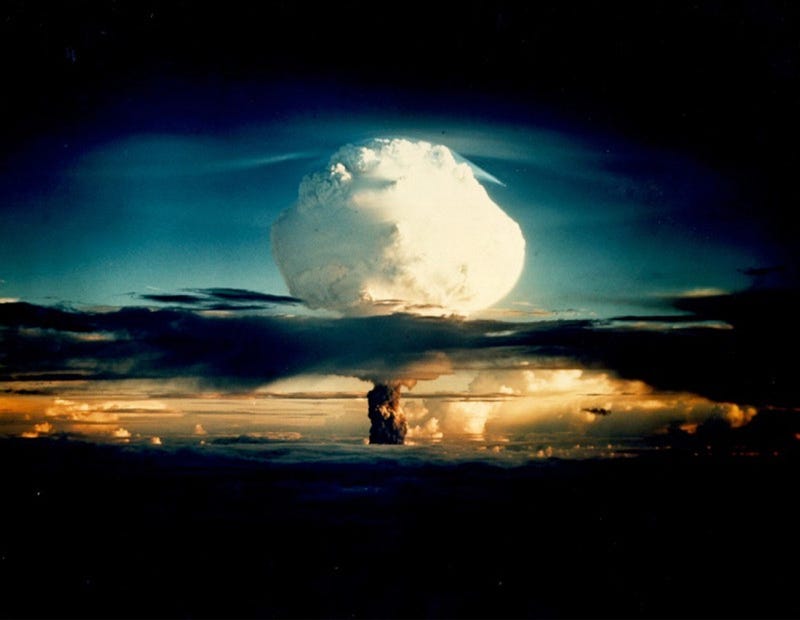The Legacy of Ivy Mike: Unraveling the Hydrogen Bomb's Impact
Written on
Chapter 1: Introduction to Ivy Mike
The Ivy Mike test, executed on November 1, 1952, represents a crucial point in nuclear weapon history. As the inaugural comprehensive test of a hydrogen bomb, Ivy Mike not only validated the catastrophic potential of thermonuclear weapons but also carried significant environmental and geopolitical ramifications. This article explores the context, implementation, and consequences of the Ivy Mike test, highlighting its dual legacy as a scientific milestone and a cautionary narrative.
Chapter 2: The Quest for Thermonuclear Supremacy
Operation Ivy was the overarching initiative that included Ivy Mike, aiming to develop thermonuclear armaments. The test was carried out at Enewetak Atoll, chosen for its remoteness and prior use for nuclear experiments.
Section 2.1: Technical Aspects of the Device
The Ivy Mike device, an engineering marvel weighing 82 tons, utilized the Teller-Ulam design, facilitating a fission reaction to trigger a fusion reaction.
Section 2.2: Cold War Context and Strategic Decisions
In the wake of World War II, increasing tensions between the United States and the Soviet Union led to a nuclear arms race. The pursuit of the hydrogen bomb was deemed vital for sustaining a strategic edge. President Harry S. Truman's directive to advance the hydrogen bomb's development was a direct response to Soviet advancements and influenced U.S. nuclear policy.
Section 2.3: Planning and Logistics
The selection of Enewetak Atoll as the test site was influenced by its isolation and the minimal impact on local populations. The intricate design and construction of Ivy Mike marked a departure from previous atomic devices.
Chapter 3: The Day of the Test

Section 3.1: The Detonation
This historic event occurred on Elugelab Island in the Marshall Islands, resulting in the island's complete destruction and leaving a significant crater in its wake. At 7:15 AM, the test produced an explosive force of 10.4 megatons, reaching heights of 57,000 feet in just 90 seconds.
Section 3.2: Immediate Consequences
The explosion completely obliterated Elugelab Island, forming a crater over a mile wide and 164 feet deep. Observations from the explosion included data on yield, radiation effects, and atmospheric changes.
Chapter 4: Aftermath and Long-term Impact
The first video provides an overview of the nuclear arms race and the significance of Ivy Mike within that context.
Section 4.1: Acceleration of the Arms Race
The test heightened the nuclear arms race, compelling the Soviet Union to hasten its own thermonuclear initiatives, culminating in their first successful test in 1953.
Section 4.2: Diplomatic Ramifications
The Ivy Mike test diminished prospects for arms control negotiations with the Soviet Union, underscoring the U.S.'s commitment to advancing nuclear capabilities.
Section 4.3: Environmental and Human Consequences
The long-term environmental impact on Enewetak Atoll included radiation contamination, complicating rehabilitation efforts and affecting local ecosystems. Additionally, the test led to the displacement of the Marshallese people from their ancestral lands, resulting in enduring health issues.
Chapter 5: Ethical Considerations and Public Perception
The second video discusses the testing of the first hydrogen bomb, illustrating the historical context surrounding nuclear weapons.
Section 5.1: Scientific and Ethical Responsibility
The role of scientists in the development of nuclear weapons raised profound ethical dilemmas during the Cold War, leading to internal conflicts within the scientific community regarding the hydrogen bomb.
Section 5.2: Cultural Impact of Nuclear Anxiety
The Ivy Mike test and subsequent detonations significantly influenced public perceptions of nuclear armaments, contributing to the rise of the anti-nuclear movement and shaping societal attitudes towards living under the threat of thermonuclear war.
Chapter 6: Ivy Mike's Legacy in the Modern World
As we reflect on the events of Ivy Mike in the 21st century, it serves as a sobering reminder of the persistent threat of nuclear proliferation. This narrative underscores the importance of continued discourse on global security and preventative measures.
While the Ivy Mike test showcased remarkable human ingenuity and scientific advancement, it simultaneously posed profound ethical questions and left an indelible mark on the environment and communities. The legacy of Ivy Mike is both a historical landmark and a cautionary tale for generations to come.
Thank you for reading.
?? Rah Tech Wiz
Want to support my work? Become a Medium paid subscriber to access more of my articles and stories.
About the Author
Susan Rodriguez is an Independent Tech Researcher at SQIFI. Connect with her on LinkedIn.